Date : Ιούνιο του 2019
Location : Ίδρυμα Ευγενίδoυ
Date : Ιούνιο του 2019
Location : Ίδρυμα Ευγενίδoυ
After successfully completing tidal flow art’s project I am accustomed to seeing the world through images at Eugenides Foundation in 10-12-19 and 25 June 2019, a second series of meetings following the same concept was planned for June 2020, that would be held again at Eugenides Foundation (Athens Planetarium) following the same concept. Due to Covid lockdowns and restrictions the event was postponed for 2022.
The purpose of the meetings is to recognize the reality of the socio-political context in which artists work without presenting the artistic works merely as an illustration.
Three (3) evenings where (3) scientists and (3) artists meet one at a time, and end up in a dialogue with the audience, where the viewer’s interest shifts from understanding the meaning of the artistic work, to the participatory experience itself, to an artistic event shared with others.
The participation of the public is essential to complete the purpose, which is not to simply see the work, but to feel immersed in it.
In present time, images tend to replace not just our verbal communication but also our physical contact with others. There is a common denominator between art and science. Are both a reflection of objective reality? Is there any logical interpretation of artistic creation? Can a scientific theory analyze the work of art?
The above are some of the topics on which art and science, through exhibit practices converse and explore.
At first the public was puzzled, as these actions were very innovative for the audience – watching the arts or sciences respectively. Usually these audiences do not meet very often. But the initial uneasiness turned into enthusiastic participation, with over a hundred and fifty people at each meeting taking part.
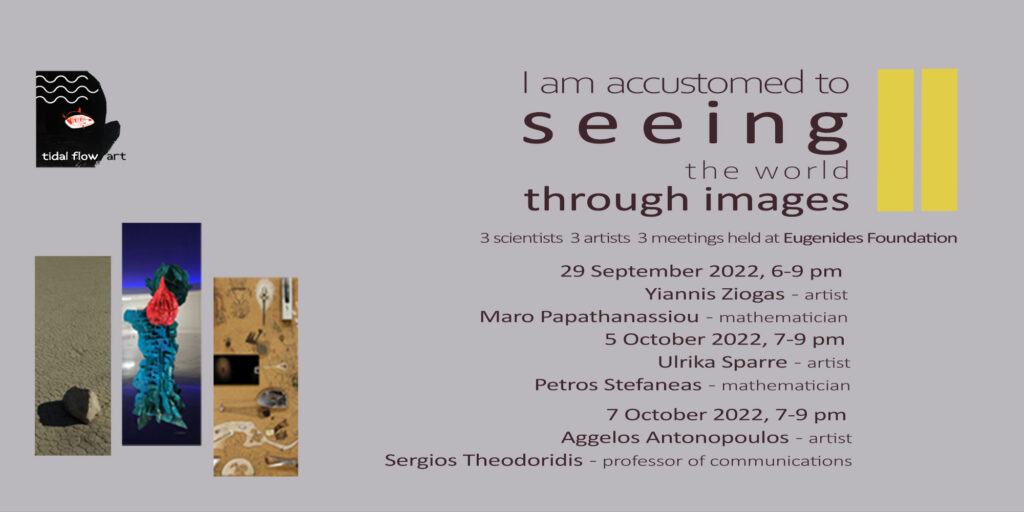
First Meeting
29 September 2022, 6-9 pm
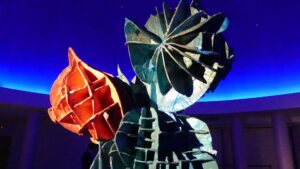

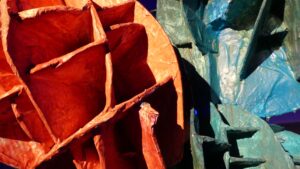

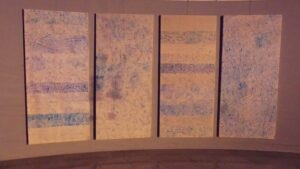
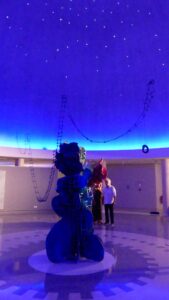
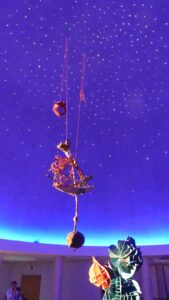
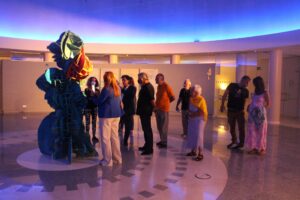
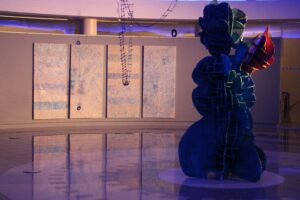
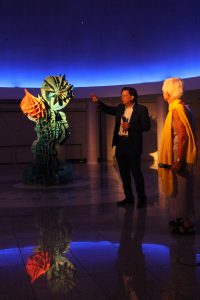

Interactions of Worlds
The installation Interactions of Worlds is formed around the energy intensity of the work Blue Sun which is placed in the center of the Planetarium Hall. Blue Sun, a 2.5-meter high sculptural structure, creates energy lines that spread throughout the Hall space and diffuse around the space. Objects are suspended from these lines – reminders of transition and movement. The dome of the Planetarium, with its blue hue and the stars that are spread everywhere on its surface, becomes part of the installation Interactions of Worlds, creating the illusion of the infinity of the Universe. The spectators are also part of the installation while moving through space and are themselves transformed into planets of an imaginary universe.
Yiannis Ziogas
Dean at the University of Western Macedonia
https://eetf.uowm.gr › teaching-stuff › ziogas-giannis
https://www.ert.gr › perifereiakoi-stathmoi › florina › florina-kosmitoras
The starry sky has always been a source of inspiration for the human beings. Homer describes how Hephaestus built and crafted the “shield of Achilles”, depicting the sun, the moon and some brilliant constellations. For Yiannis Ziogas, the “Achilles Shield” has been an inexhaustible source of inspiration for many years. But he does not try to imitate Hephaestus. Like any artist-creator, he forms his own image of the world within himself, which he tries to implement based on his own technique and using various materials and means. Inspiration makes him disengage from anything superfluous to reach through abstract approach the realization of the essential.
Maro Papathanassiou
Emeritus Professor of Mathematics at the University of Athens
Second Meeting
5 October 2022, 7-9 pm
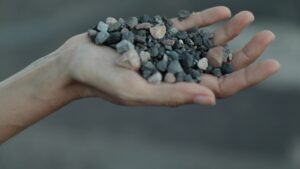
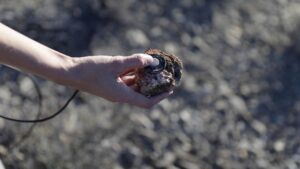
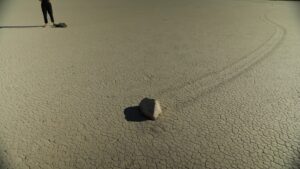
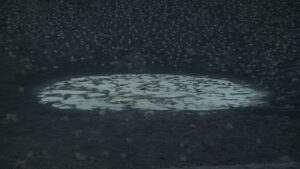
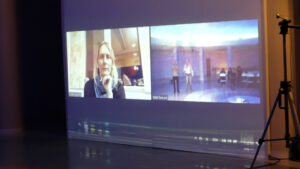
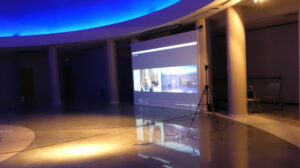
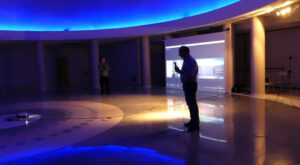
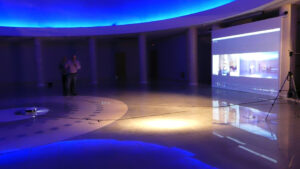


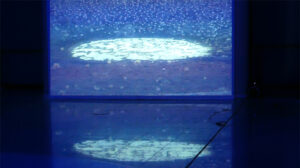
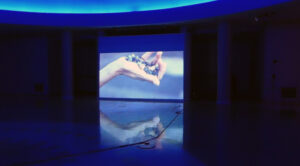
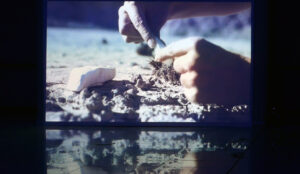
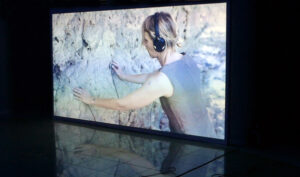
Ear to the Ground, 2020
I believe humans constantly value existence in relation to one’s life. In other words, how long one’s own life is. The imagination of a stone is a way to put eternity and aging in perspective. Perhaps the stones hold this inexplicable language which can be understood from the beginning of time and throughout the imaginable future. A stone could provide us with all the answers, even the origin of human existence. Holding a stone in one’s hand is like holding millions of years. Stone is the only material we can imagine which will survive us, and breaking or carving into the stone’s surface is in some sense irreversible.
Ulrika Sparre
visual artist from Sweden
The semiological representation of artistic visual space is a complex process to which both mathematics and logic can contribute. Geometric theories form the necessary basis for this study in both the version of Euclidean geometry and non-Euclidean geometries as well. A step that can take the geometry-based methodology further is to link it to theories of meaning and truth from the perspective of logic. Based on such a proposed composition we have the pleasure of conversing with Ulrika Sparre’s work. The position of the ear on the ground as sought by the creator can be understood by such mathematical approaches, giving a new perspective to her work.
Petros Stefaneas
Associate Professor of Applied Mathematics and Natural Sciences, NTUA
https://www.linkedin.com/in/petros-stefaneas-38b8196
Third Meeting
7 October 2022, 7-9 pm7
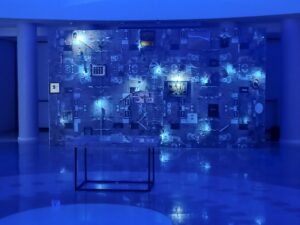
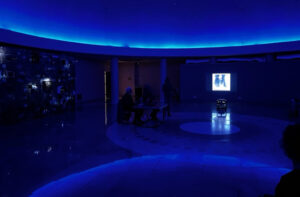
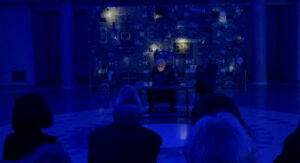
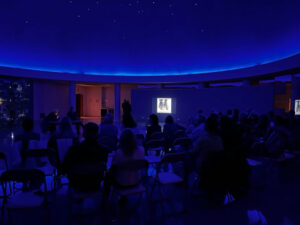

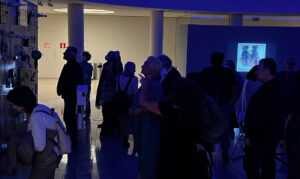
Objects of a Personal World, 2007
With Objects of a Personal World, Aggelos Antonopoulos is composing a world where he feels its meaning but lacks control of it. He feels, amidst a creative process of research. In creating a autobiographical picture. A special element is the black foot in the work for the autonomy that characterizes it. The artist says that…having gone through this adventure, I reached the point of making something autonomous as a conclusion, that my world is unknown because I am in its making. The conclusion may perhaps be inferred by viewing this world from a distance as much geographical as chronological.
Aggelos Antonopoulos
Dean at Athens School of Fine Arts
www.asfa.gr › aggelos-antonopoulos
Artificial Intelligence: The End of Art or a New Beginning?
Art, Science and Technology as forms of creation of the human imagination, have a close historical relationship of interaction. In the evolutionary course of our culture, each new scientific-technological development launched corresponding developments in Art, adding new tools for experimentation but also new ways of presenting works of art, new ways of public participation, new ways of “seeing” a work of art.
At the dawn of the new era, artificial intelligence (AI) and blockchain technologies have already launched such processes. Now however, there is a significant qualitative difference compared to previous historical moments. New technologies, beyond the new “tools” and techniques they offer to the creator/artist, they can “create” works of Art. Is technology, that is, upgraded from a simple tool at the service of the creator to the “creator” himself? What does this mean for Art? Does it signal an impending end to Art and the creator/artist, or does it signal a new beginning?
Sergios Theodoridis
Emeritus Professor of Signal Communications and Processing at University of Athens
http://cgi.di.uoa.gr/~stheodor/
Distinguished Professor, Aalborg University, Denmark